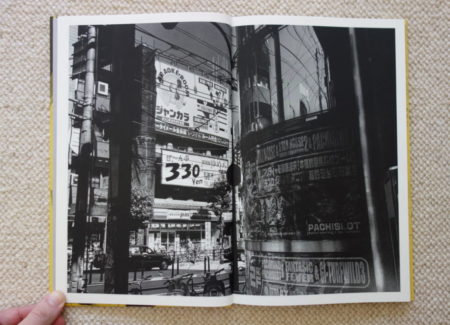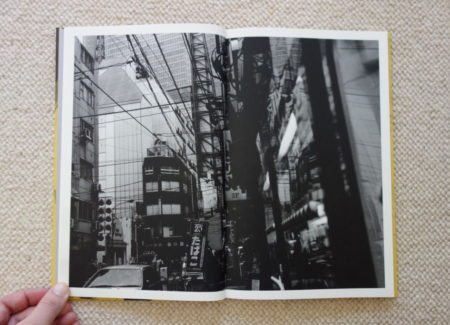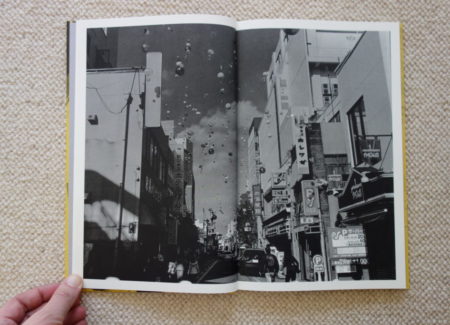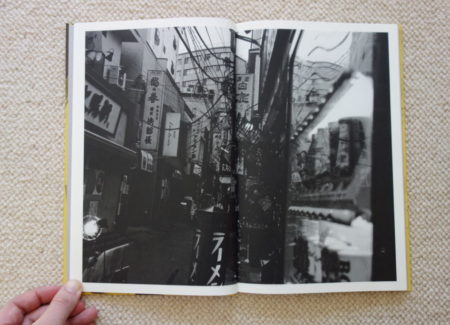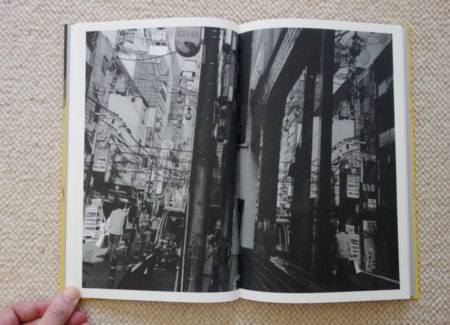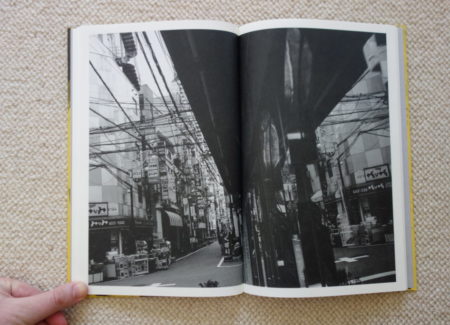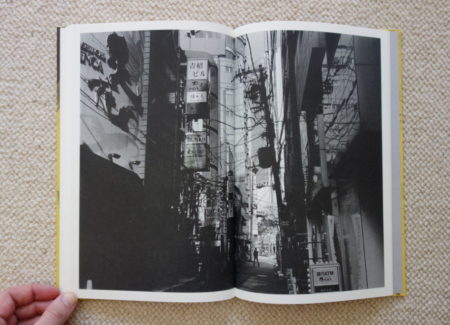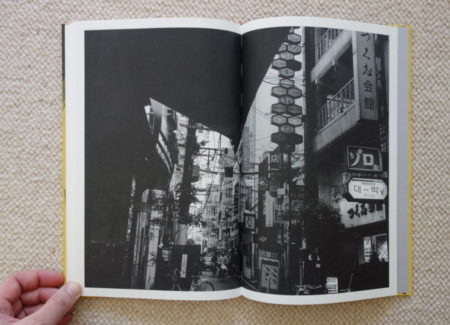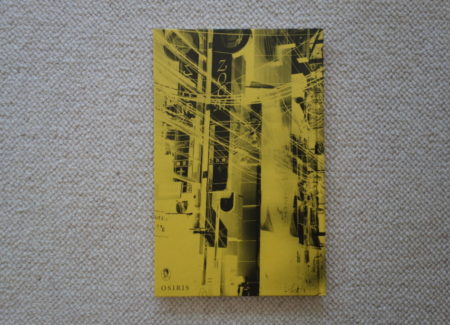JTF (just the facts): Published in 2017 by Pierre von Kleist Editions (here) and Osiris (here). Hardcover (with reversed exposure), 88 pages, with 40 black and white photographs. Includes an essay by Chris Fujiwara. (Cover and spread shots below.)
Comments/Context: While many notable Japanese photographers have captured the bustling spirit of Tokyo and other large Japanese cities, few have done so with as much consistent innovation as Osamu Kanemura. Kanemura burst onto the scene in 1996 when he was included in “New Photography 12” at MoMA, and he cemented that acclaim in 2001 with his landmark photobook Spider’s Strategy, a body of work that turned the ubiquitous overhead electrical wires of Tokyo into a sticky web of black lines that threatened to overwhelm the surrounding architecture. What made those pictures so remarkable was how he turned something so boring and obvious into a vaguely menacing presence, the dense nests of wires suddenly everywhere, the city seemingly choked by these amazing clusters of graphic interlocking lines.
Kanemura’s newest photobook, Concrete Octopus, is a worthy successor, continuing the photographer’s street-level investigation of city-life, but finding yet another intriguing visual metaphor to explore. In these new pictures, the octopus is the clamoring city itself, with buildings, signage, and the thick clutter of urban activity grasping upward like the waving tentacles of the undersea beast.
Kanemura’s frames are filled to the point of overstuffing, with the sky just a tiny sliver in many of the arrangements. From a largely sidewalk perspective, he looks slightly upward, his gaze under siege from the bright banners, flashing lights, and bold advertising billboards, his attention drawn from the street vendors all the way up the sides of the nearby buildings, the intrusion of lamp posts, telephone poles, and electrical wires adding to the sense of visual distraction. In many images, the buildings seem like they are falling inward, creating a cluttered claustrophobia – he is surrounded by the intensity of the streets, the narrowness hemming him in.
Kanemura exaggerates this unease by consistently employing off-kilter camera angles, tilting the view, almost as if he was trying to get out from under the city, shrugging, turning, and ducking to avoid its constant cacophony. He uses the dark forms of overhead awnings, storefront lighting, and sharp-edged overhangs to jut into his compositions, pushing us to one side or the other. Covered markets, pachinko parlors, street vendors, skyscrapers, and construction sites all become sources of conflicting patterns, and Kanemura slams them together with off-balance brashness and layered force.
Like many street photographers, Kanemura isn’t afraid to use the reflections in nearby storefront windows to animate his pictures. For the most part, he’s leveraged the intimacy of a close-up glass surface (even a vending machine or two function quite well) to double the action on the street, creating repetitions, mirrored effects, and even one fractured self-portrait. In other pictures, the sideground storefront takes up almost half the frame, bumping into and disturbing the rest of the action. It’s as if the encroaching density of the action around the sidewalks is too much, with everything fighting for attention, pushing, crowding, and jostling our view.
People are largely an afterthought in these pictures. When they do appear, they are an ephemeral presence, flitting in and out of our peripheral vision. Things quiet down a bit in the back alleys, where piping, air conditioners, and dirty electric boxes tussle with parked bicycles and scooters, the relative calm a welcome break from the over stimulation of the busy streets.
With all this eye-catching activity taking place, it’s hard to imagine that loneliness and muted estrangement could creep into Kanemura’s photographs, but they do. He seems to scan the aggregation of surfaces, seeing the avalanche of details but also somehow watching from afar, turning the overwhelming reality into a personal exercise in distancing and abstraction. For an artist with an excess of attention, the city requires a filter, and Kanermura’s camera collapses the messy inputs into an ongoing test of on-the-fly rearrangement.
While many photographers have sought to find the elegant order in cities, Kanemura has done just the opposite. His best images sizzle with interruptions and deliberate distractions, so many that we can hardly process them all, and when we slow down to investigate his pictures more closely, the layers of patterns and graphic elements telescope into the distance in immoderate overabundance. In these photographs, Kanemura has captured the electric energy of an overdose, and left us reeling with a satisfying visual hangover.
Collector’s POV: Osamu Kanemura does not appear to have consistent gallery representation at this time, at least in the United States. As a result, interested collectors should likely connect directly with the artist via his website (linked in the sidebar).


